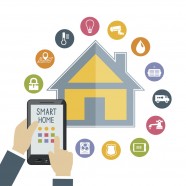
Ideally, new homes are built for the future as well as for today. If you’re building a new home, you’re probably planning on staying there for years, if not decades. We’ve gone through a massive surge in electrical and data improvements in the last decade. The next ten to twenty years promise to show us even more. It’s harder to play catch-up if you don’t have the base materials installed. We have no way of knowing exactly what appliances we’ll be using in twenty years, so the smartest move is to include basic variable options in your new construction electrical plan.
Smart home wiring isn’t as much about adding new items now, as it is about leaving options open for later. Yes, high tech smart homes today can do amazing things, from giving you the ability to turn on lights from your smart phone to changing lighting according to the way you use a room, but that’s only part of the attraction. Leaving open-ended possibilities in your wiring plan will make it easier and less expensive to upgrade to the latest tech version when it’s time to install it.
Wall Switches
Have your electrical contractor install a neutral wire in each wall switch. Many of the newer dimmers, switches, and keypads require a 3-load (hot, neutral, and load) connection. Neutral cables are optional for many building plans today, and if you don’t specify it, your contractor may omit it.
Whole-House Surge Protection
A whole-house surge suppressor will protect your entertainment products and computer setups. Adding this protection before adding more smart options will protect your delicate devices from power surges and sudden blackouts.
Wiring for Data
More and more, the smart home will be automated through installed data lines. Your residential electrical power plans should include elaborate data wiring designed to handle multiple times your current usage. Installing an Ethernet network will enable you to run your A/V lines, security system, land line telephone, and HVAC through one central hub. This should be set up where most external cabling, such as cable tv, satellite, and phone, runs into the house. Ideally, you should put this near your audio/visual room so the cables from the entertainment equipment can feed into it, as well.
This hub can neatly house CD jukeboxes, DVD players, game systems and other electronic equipment, leaving your entertainment room with a sleeker look. You can either build a cabinet or shelving unit designed to hold all this equipment, or design a special closet or small room to camouflage the hub.
In-Wall Remote Controls
One of the charms of a smart house is the ability to use appliances from a distance. Turn your television off if you forgot in the rush to go to work. Start the washing machine to have laundry clean when you get home. In-wall transmitters control groups of lights or other appliances. You’ll want your contractor to install a number of these throughout your home.
The Need for Speed
A few short years ago homes had wired telephones and one desktop computer. Today’s home is more likely to have no land line at all. Instead, families own multiple cell phones, and it’s not unusual for each member of the family to have one or more computing devices such as tablets or laptops. Conventional phone or data wiring can’t handle the power and data needed to run all these devices, especially when multiple ones are being used at the same time. A high speed data network combined with superior grade television cabling is needed to supply the data needs for today and for tomorrow.
If you’re in the process of starting a new construction electrical project, consult with us before you begin. You’ll find it’s worth your time to do so.

Recent Comments